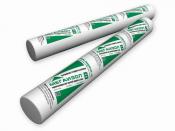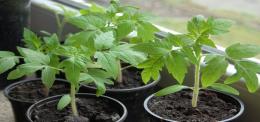Search
Login
Recommended
We plant seedlings in April, seedlings in April, the lunar planting calendar for 2018
Although April can be confidently called the spring month, there is no reason to dream of a stable temperature, especially in its first half. Often during this period there are frosts, snow may suddenly fall, and after a couple of hours it will melt under the rays of a very summer-like hot sun. It is such unpredictable differences that keep gardeners from starting sowing and actively hardening young seedlings.
There is a lot of work in the garden and garden, the weather constantly makes adjustments to the usual order of their implementation. That is why experienced vegetable growers recommend that a work plan be prepared in advance, of course, taking into account the phases of the moon and the signs of the zodiac constellations indicated in the lunar calendar for April 2018.
Content:
- What seedlings are planted in April video
- April seedlings of vegetables - care rules, when and how to water
- Planting seedlings in open ground
- Seedlings of flowers in April
- Lunar calendar, landing days in april 2018
What seedlings are planted in April
In April, they usually repair and prepare garden equipment, plan beds, draw up a plan for the placement of vegetable crops, and clean the site. If the beds are prepared in the fall and the soil has already dried out sufficiently, then you can try to sow the seeds of frost-resistant crops in the ground in the open, or, if possible, under a temporary film shelter.

But the main work is still being done in a house or a heated greenhouse, it consists in the quality care of seedlings.
Also in the first decade of April, you can sow the seeds of some vegetables, herbs and flowers indoors, and without any problems get excellent seedlings.
For example, if at the end of March it was not possible to plant tomato seeds of early ripening, then the beginning of April is quite suitable, the seedlings will receive a sufficient amount of light, it will not be required to spend on the installation of special lamps.

In early April, you can also sow the seeds of marjoram, savory, tarragon and basil, catnip and hyssop.
how to get seedlings of pumpkin, zucchini and squash
With the onset of the second decade of April, you can prepare containers for sowing pumpkins, zucchini and squash.
Zucchini seeds for sowing is better to use two to three years ago, plants from these:
- will be stronger, resistant to infections
- give more female flowers
- bear fruit better

Before sowing, the seeds are warmed up in the sun for a couple of days, treated with a 1% potassium permanganate solution, washed with running water.
To increase the germination of the material, you can additionally soak the seeds in a solution prepared according to this recipe:
- 1 liter of water
- 1 tablespoon of ash
- 1 teaspoon nitroammofoski
- trace element tablet
You can also use Fitosporin, 1 teaspoon of the product is diluted with a liter of warm water. Germinate seeds can be wrapped in a damp cotton fabric.
Land for seedlings is prepared according to this recipe:
- 3 parts peat
- 3 parts of turfy soil
- 3 parts humus
- some sand and rotted sawdust
You can disinfect the soil after standing it in the cold for at least two months. For each plant, you will need to prepare a personal cup with a diameter of at least 10 cm and the same depth.

The bottom should have a hole that provides a drain of water. The bottom of the cup is preferably lined with sphagnum. Recommended temperature before germination - within + 24 C, after their appearance - within + 18 C.
An important task will be to provide good lighting. Watering is carried out with warm, settled water, once every 5 days, at the rate of 1 liter per 8 plants. It is impossible to pour water on leaves and stems.
The first top dressing is done after 7 days, a mullein solution 1:10 is used, the second top dressing is carried out with complex mineral fertilizers.

You can plant zucchini seedlings in the ground after the appearance of three real leaves. The seeds of squash and pumpkin are sown in exactly the same way, the care of the seedlings of these plants is similar to that described above.
sow cucumbers for seedlings
Sowing cucumbers for seedlings intended for planting in open ground should not begin earlier than April 15.
The seedling method of growing cucumbers allows you to accelerate the process of obtaining the crop by more than two weeks. To verify the suitability of the seeds, it is recommended to lower them in a 3% saline solution.
Only those grains that sink to the bottom are prepared for planting. Selected high-quality seed is immersed in a 1% potassium permanganate solution for about half an hour, then washed and laid between layers of wet cotton fabric - for germination. For the appearance of sprouts, a temperature in the range from + 25 C to + 30 C is required, the germination period is 2 - 4 days.

Since transplanting cucumber seedlings is a problematic task, it is better to grow it in peat mugs, or in plastic cups, each plant separately. The containers are filled with a substrate consisting of peat, sod soil, sawdust. Do not fill the cups to the brim.

Lay out one seed in cups. Water the soil as it dries. The emergence of seedlings can be expected in a week. Another two weeks will need to care for seedlings in greenhouse conditions, then it can be planted in open ground.
Of course, before this you need to make sure that the weather forecast is favorable for the development of these plants.
sow winter cabbage for seedlings in April
The last days of the month can be devoted to sowing late-ripe varieties of winter cabbage. Mid-ripening varieties are recommended to be sown on seedlings in late March or early April. The main condition for obtaining an excellent harvest will be the purchase of high-quality seeds and their proper preparation for sowing.

Experienced gardeners argue that the resistance of cabbage to fungal infections can be developed in this simple way:
- seeds to withstand for 20 minutes in water at a temperature of + 50 C
- then stand 5 minutes in cold water
But if you buy processed seeds, then subjecting them to soaking is not recommended.
To speed up the process of germination, untreated seeds are placed between the layers of moistened tissue and left in a warm room for a day. Next, the seed is dried and sown in the soil.

Soil for seedlings of cabbage can be prepared by the following formula:
- 1 part humus
- 1 part soddy soil
- 1 tablespoon of wood ash per 1 kg of soil mixture
There are other recipes for making the substrate, but it must be light and permeable to air.
It is recommended that you first calcine the soil in the oven to disinfect it. Before sowing, it is recommended to moisten the substrate well - the next watering can be carried out after emergence. For watering, it is recommended to use 1: potassium permanganate solution.

Before emergence, the containers are kept in a warm room. After the sprouts of the container appear, they should be taken out to a cool room for about 10 days. This will avoid stretching the seedlings. Then, already strong plants can be kept at higher temperatures, in the range + 12 - 15 C.
Watering should be carried out with warm water, but very carefully, in minimal quantities.
Cabbage is dived after the appearance of the second real leaf, i.e. after about 12 days, either in personal cups, or directly in the greenhouses.
Watering is done as the soil dries. Plants ready for planting in open ground should have 4-5 true leaves.
April seedlings of vegetables - care rules, when and how to water
Before sowing the seeds, the soil is moistened, from irrigation to the emergence of seedlings usually refuse. But with seed germination, the rapid development of small plants begins, a significant amount of moisture will be required.
Watering should be planned in such a way that the soil in the tanks never dries up, but water stagnation should also not be allowed.

Water for irrigation should be defended, it is recommended that its temperature be 2-3 degrees higher than the temperature in the room. Thin seedlings are watered neatly, it is convenient to use a teapot for this, grown plants can be watered in a tray.
temperature condition
In order for the seeds of cold-resistant vegetables to sprout, it will be sufficient to maintain the temperature within + 18 - 23 C. Heat-loving plants will require raising the temperature to + 25 - 30 C.
But after the emergence of seedlings for all groups of plants, it is recommended to slightly lower the thermometer - otherwise, such a negative phenomenon as extension of seedlings will be observed. After about a week, the plants can be returned to a warm room.
in which cases a pick is required
Diving seedlings sown in April is not necessary. It can be immediately planted in the ground in late April or early May. But provided that the weather will be favorable.

If the weather is cool and rainy, then you have to dive. On the positive side, picking inhibits the development of plants for a while, the quality of the seedlings does not suffer, on the contrary, their root system becomes stronger.
After a dive, plants should be protected from direct sunlight for several days.
But you can not pick out all the vegetables! Pumpkin plants and cucumbers such a procedure is strictly contraindicated.
fertilizing seedlings
Seedlings of vegetable crops definitely need additional nutrition. The best time for their application is three to four days before the planned landing in the ground. The nutrient mixture for plants can be infusion of wood ash, solutions of mullein or chicken droppings of low concentration.
The best mineral supplements are complex products:
- Kristallin and the Ideal
- Mortar and Kemira

Fertilizing should be done after watering the soil, this will protect the roots of plants from burns. After fertilizing, you should also water the plants with a small amount of clean water.
Planting seedlings in open ground
Under appropriate weather conditions, the end of April for most summer residents becomes a period of planting seedlings in open ground. It is not recommended to allow seedlings to be transplanted before planting; the survival process from this is complicated. Work in the beds begins as soon as the soil warms up. But first of all, crops that are resistant to frost should be planted.
But it is recommended to pre-harden such seedlings, it takes a couple of weeks for the plants to get used to temperature extremes.

During this period, it will be necessary to take containers with seedlings to an unheated balcony or to the veranda, and to air the room several times a day. But drafts cannot be done.
The time of air procedures is gradually increasing, seedlings begin to be put on the face over time, containers can be exposed in the lighting area in direct sunlight. The last days before planting the containers with seedlings in the house are not cleaned, they are in the open air around the clock. These measures are necessary, in case of sudden freezing, or vice versa, too hot weather, hardened plants will be able to survive.
Seedlings of flowers in April
Throughout April, seeds of ornamental and flowering plants continue to be sown. Recall the most popular.
kohiya
So botanists call the ornamental plant, often grown on the site, better known as summer cypress. Its bright salad-colored leaves and a noble form will give special appeal to flowerbeds, group plantings or single-planted bushes of kohii - this is a great opportunity to place accents in the landscape garden, they effectively look like framing garden paths, in rutarias and rockeries.

You can plant cochia seeds either at the beginning of April, or at the end, the soil can be used universal. The seeds are not deepened, laid out on the surface and covered with a small layer of clean sand. Watering the crops is done with a spray gun, to accelerate the germination of seeds, the soil is covered with a layer of film. It will take about 10 days to wait for the shoots.
After the appearance of the third leaf, the seedlings are dived, upon reaching it a height of 10 cm - you can begin to land in the ground.
annual asters
The darling of summer residents, annual aster can also be sown since March and continue sowing in the first decade of April.
The soil for plants should be light, the ideal mixture:
- turf land
- peat
- sand

Seeding depth - 5-8 mm. After a week, emergence can be expected. It is not recommended to plant asters in the area where the bulbous flowers grew. Too high will be the risk of damage to their roots by fungal diseases.
ageratum
Although this plant has long been considered acclimatized to the conditions of the Middle Strip, it is not worth rushing with its landing, yet it remains thermophilic.
Aperratum is sown in partial shade or in areas open to the sun. It is grown in containers on verandas and balconies, in the open ground they are used in the design of rabatoks and mixborders.

Small seeds of ageratum are scattered on the soil surface, sprayed with warm water, the containers are covered with pieces of glass or film and kept in a warm place.
Shoots appear after 10 days, picking is done after the appearance of 4 leaves.
catchment or aquilegia
This perennial looks great in a garden or flower garden, easily propagated by dividing bushes or self-seeding.
The seeds are small. They are laid out on the surface, sprinkled with earth. To speed up seedlings, you can scarify the seeds with sandpaper.

The picking of seedlings is carried out after the appearance of three leaves, in early June - they are planted in the ground. To flowering lasted as long as possible, and the plant itself felt comfortable, it should be planted in partial shade, preferably on sandy soil.
amaranth
The plant is grassy, \u200b\u200bbut large enough, about a meter and a half high. Red Indian amaranth attracts with its bright leaves and shoots, unusual shape and unpretentiousness to growing conditions.

When sowing seeds sprinkled with a mixture of peat and sand, the germination of the plant is long, can last about 3 weeks. Before planting in open ground, seedlings are recommended to be tempered.
annual dahlias
These small plants are unpretentious in cultivation and delight in lush and extremely bright flowering. For sowing, you can use a universal soil mixture.

Germination temperature is within + 25 C. The emerged seedlings dive after two to three weeks, planting plants in personal pots.
daisies
If you did not have time to sow them for seedlings earlier - do not worry, this can be done throughout April. Seeds germinate on about 10 days, provided that the containers are kept at a temperature of + 20 to + 25 C. Dive is performed two weeks after the emergence of sprouts.

Daisies are planted in open ground in groups, on lawns, they look beautiful among low grass, they can be used as a frame for paths. Flowering is long, from spring to the onset of autumn frost.
Lunar calendar, landing days in april 2018
To create the most comfortable conditions for plants and to contribute in every way to their rapid development, we will use information about the phases of the moon and carefully study the lunar calendar for April. It is advisable to plan work on the appropriate days.

Naturally, the first fine days should be devoted to cleaning the territory, repairing greenhouses and greenhouses. It is also necessary to make repairs and revisions of tools and equipment, to purchase everything necessary for optimizing agricultural work.
Starting from April 2 to April 8, you can begin to field work, namely, you can plant in the ground:
- onions and beets
- jerusalem artichoke and potatoes
- daikon and radish
- root parsley and radish
In addition, from April 4 to 6, you can sow carrots.
According to the weather on April 7 in the old days they made a forecast. Fog in the morning and sunny day - to a good harvest.
On the waning moon, from April 9 to 11, it is recommended to lay compost pits, build irrigation systems and make fertilizers.
Landing operations can be resumed starting from the 12th-13th, when the waning moon passes into the sign of Pisces. The same plants are subject to planting, a list of them can be supplemented with corms flowering plants.
! 4 and 15 - you can do fertilizing plants and pest control of the garden.
For the new moon, which comes April 16, it is best to plan a day of rest.
On the 17th and 18th, you can sow seedlings of squash, pumpkin, cucumbers, greens, winter cabbage, and melons. In the garden, you can plant shrubs and seedlings of trees, remove dry branches. You can also thin out seedlings of early plants.
April 19th and 20th are days ideal for fertilizing and watering plants.
On the 20th and 21st, you can continue working on the site, a great time for sowing salads, herbs, tomatoes, and onion-batun in open ground. Planting of bulbous and tuberous ornamental plants is also recommended.
On the 23-24th, you can add mineral fertilizers to the beds, these days you can check whether there are enough seeds and make successful purchases of planting material.

From the 25th to the 28th, while the growing moon is in the constellation Virgo, you can continue to apply mineral fertilizers and sow salad, cabbage, and tomatoes. Under the film coating, you can sow eggplant, pumpkin, cucumbers. We continue to plant flowers: annuals, bulbs and corms.
Watering plants that require additional portions of moisture is best done using the root method.
April 29 is the most favorable day for planting zucchini and squash, cucumbers and pumpkins. You can also plant green seeds and onion-batun.
On the 30th, on the day of the full moon, it is better to plan a day of rest.
As for the care of seedlings, the best days for a dive and transplant in April are as follows:
2-3
12-13
21-22
25-28 seedlings should be weeded and thinned.

Of course, you should not observe the landing dates in bad weather conditions, adjusting for the climate of this summer season and the specific location of your site - the conditions are mandatory! Yes, and your own health should be taken into account!





